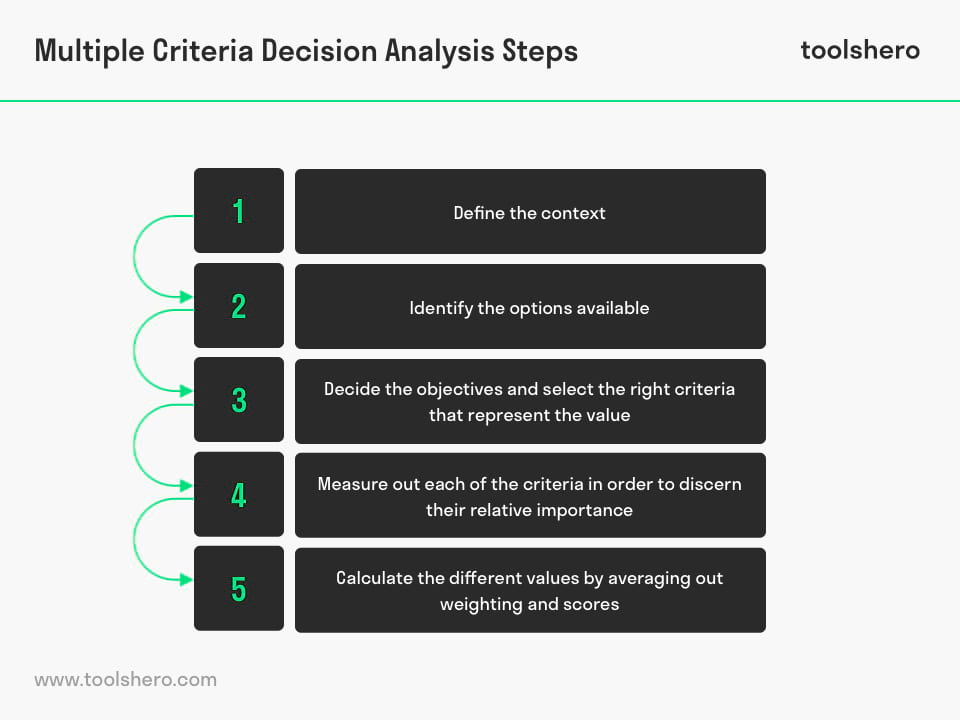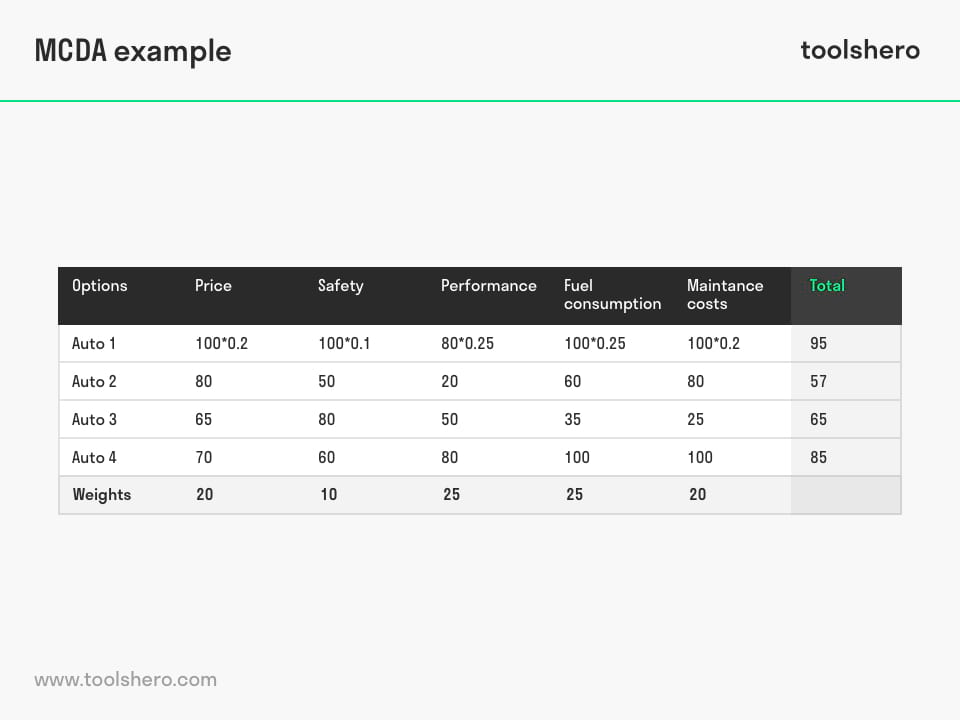Multiple Criteria Decision Analysis (MCDA)

Multiple Criteria Decision Analysis (MCDA): this article provides a practical explanation of the concept of Multiple Criteria Decision Analysis (MCDA). This article contains a detailed explanation of MDCDA, the steps involved and a practical example. After reading it, you will understand the necessity and the benefits of Risk Analysis. Enjoy reading!
What is a Multiple Criteria Decision Analysis (MCDA)?
A Multi Criteria Decision Analysis (MCDA), or Multi-criteria analysis (MCA), is a decision-making analysis that evaluates multiple (conflicting) criteria as part of the decision-making process. This tool is used by practically everyone in their daily lives. Humans make thousands of decisions per day, but this same process also occurs in the corporate world, government organs, and medical centres. A MCDA is therefore useful in group decision making.
A Multiple Criteria Decision Analysis (MCDA) resembles a cost-benefit analysis, but with the notable advantage of not being solely limited to monetary units for its comparisons. When making comprehensive or important decisions, multiple criteria and levels of scale need to be accounted for.
Comparing conflicting sets of criteria, such as quality and costs, can sometimes lead to confusion and lack of clarity. Taking decisions based on multiple different criteria with help from the Multiple Criteria Decision Analysis (MCDA) tool can then make things clear.
By structuring complex problems and analysing multiple sets of criteria, informed, more justifiable decisions can be made.
In 1979, Stanley Zionts published an article titled ‘MCDM – if not a Roman numeral, then what?’ Which he used to promote and popularise the concept among his business audience.
The following years saw sustained popularity of the concept, and multiple Multiple Criteria Decision Analysis (MCDA) related organisations were founded, such as the ‘International Society on Multiple Criteria Decision Making’. A comprehensive Multiple Criteria Decision Analysis (MCDA) draws knowledge from several different fields, including mathematics, economics, information technology, software engineering, and other information systems.
Steps in a Multiple Criteria Decision Analysis (MCDA)

Figure 1 – Steps to Create a Multiple Criteria Decision Analysis
1. Define the context
Before you can get started on a Multi-criteria analysis, you need to clearly define the context of your analysis. The context accounts for the present situation, key players, and stakeholders in the decision-making process. Advantages of a clearly defined context are:
- Optimal allocation of resources towards accomplishing the objectives
- Improved communication between the different parties involved
- Facilitating multiple additional options
- Mapping out strengths and weaknesses, as well as threats and opportunities. The SWOT Analysis can be a helpful tool in this regard
- Recognition and possible filtering out of environmental uncertainties in the environment that the analysis is being conducted in. A PEST analysis can help with that.
2. Identify the options available
An Multiple Criteria Decision Analysis (MCDA) compares multiple different options to one another. Whether pre-established or yet to be developed; all options are subject to being changed and influenced.
This is why all the options need to be adjustable even though the analysis has already started. Options are often formulated on a go/no-go basis. The consequences tied to each option determine whether they lead to a go or no-go decision.
3. Decide the objectives and select the right criteria that represent the value
Consequences play an integral role in the Multiple Criteria Decision Analysis (MCDA).
Due to the varying consequences tied to each option, for example, a higher Return on Investment (ROI) after an investment or a degradation of product quality after production line alterations, multiple different criteria need to be established.
Criteria represent clearly defined standards by which the different options can be measured and compared, as well as expressing the different levels of value each option creates.
When buying a new car, the future owner wants to minimise potential costs, and maximise the number of advantages. Costs are easy enough to compare, but advantages can be subject to varying interpretations. Which is why these two goals conflict with one another and can’t be compared directly.
In such cases the advantages, where possible, need to be sub-divided into quantifiable criteria such as safety (crash test result), comfort, luxury, reliability, and performance.
As such, the making of decisions in an Multiple Criteria Decision Analysis (MCDA) frequently comes down to matters of judgement. Objective assessments aren’t always possible.
4. Measure out each of the criteria in order to discern their relative importance
Just choosing the right criteria won’t suffice to combine and analyse the different scales of choice. One preference unit isn’t necessarily the same as another.
This is similar to comparing temperature scales such as Celsius and Fahrenheit. Both scales may concern temperature, but a difference of 1 degree Celsius is greater than 1 degree Fahrenheit.
This effect, the relative importance of something, is something the car buyer also notices when he has to make a choice between cars. The buyer can partially base his decision on the car’s costs.
But when he has made a shortlist of say five cars he’d like to have, each differing 150 euros in price, that criterion suddenly loses its importance. Whereas a difference of 3,000 euros per car could have made this a weightier criterion for the buyer.
The weighting of different criteria therefore not only shows the difference between options but also how relevant this difference is. For example, safety might weigh less heavily on the buyer’s mind than maintenance costs, because he considers it less important.
Common rating scales that can be used in MCDA for different criteria are a relative scale and an ordinal scale. You can rate each alternative relative to the others.
With a relative scale each alternative is rated relative to the others in satisfying a particular interest. For example, among the 4 alternative criteria, assign each a 1, 2, 3, or 4 depending on which satisfies the interest: the best = 4; second best = 3; third best = 2; and the worst at satisfying the interest = 1.
With an ordinal scale you use a scale of your choosing (for example, a 5-point scale, or a 10-point scale) and assign each alternative a rating for how well it satisfies a particular interest. An example of a five point scale might be: 5 = excellent; 4 = good; 3 = satisfactory; 2 = below average; 1 = poor.
5. Calculate the different values by averaging out weighting and scores
The penultimate step is where the relative priority scores are calculated. The general preference score is the weighted average of all criteria.
First off all, the scores for each criterion are multiplied with their weighting, expressed in decimals (e.g. 20 is 0.2). The scores of each criterion are than added together. The total sum of which comprises the preference score. Have a look at the example below.

Figure 2 – A Practical Example of MDCA
After calculating the totals, the outcomes can be ordered to see which option is most suitable based on the different preference scores they’ve been given. In this example, car 4 comes out on top.
It’s important to note that a high score for price doesn’t mean that the car is expensive, on the contrary, it represents how well the car fits the buyer’s budget. A very expensive car will have a low score for the criterion of price, driving down its overall score as a result.
Multiple Criteria Decision Analysis (MCDA) advantages
The use of a Multi-criteria analysis comes with various advantages when compared to a decision-making tool not based on specific criteria:
- It’s open and explicit
- The chosen criteria can be adjusted
- Many different actors can be compared with one another
- A Multiple Criteria Decision Analysis (MCDA) grants insight into different judgements of value
- Performance measurements can be left to experts
- Scores and weights can be used as reference
- It’s an important means of communication between the different parties involved in the decision-making process
It’s Your Turn
What do you think? Do you recognise this explanation of Multiple-Criteria Decision Analysis? What do you believe are contributing factors to the effectiveness of this powerful, formal, and analytical decision-maker’s tool?
Share your experience and knowledge in the comments box below.
More information
- Zionts, S. (1979). MCDM—if not a roman numeral, then what?. Interfaces, 9(4), 94-101.
- Zeleny, M., & Cochrane, J. L. (1973). Multiple criteria decision making. University of South Carolina Press.
- Masud, A. S., & Ravindran, A. R. (2008). Multiple criteria decision making. CRC Press, An imprint of the Taylor and Francis Group.
- Habenicht, W., Scheubrein, B., & Scheubrein, R. (2002). Multiple criteria decision making. Theme, 6(5).
How to cite this article:
Janse, B. (2018). Multiple Criteria Decision Analysis (MCDA). Retrieved [insert date] from Toolshero: https://www.toolshero.com/decision-making/multiple-criteria-decision-analysis-mcda/
Published on: 10/26/2018 | Last update: 08/09/2023
Add a link to this page on your website:
<a href=” https://www.toolshero.com/decision-making/multiple-criteria-decision-analysis-mcda/”>Toolshero: Multiple Criteria Decision Analysis (MCDA)</a>












